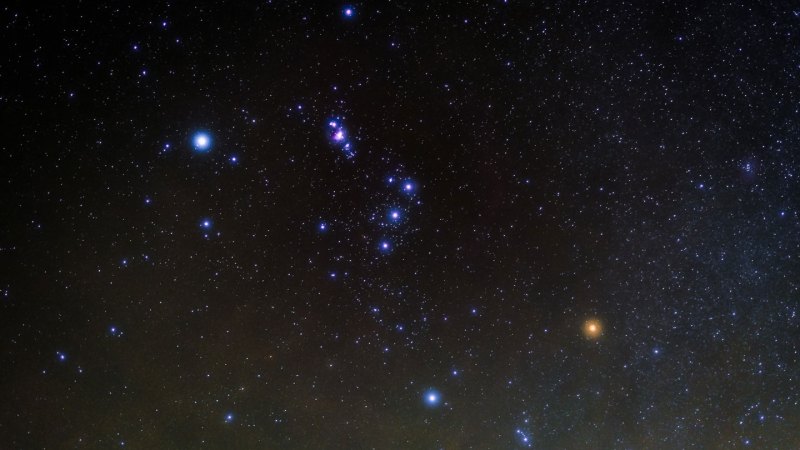
Betelgeuse, Betelgeuse! The red supergiant that marks Orion’s left shoulder may have a tiny, unseen companion.
Two independent studies found evidence of a star the same mass as the sun, orbiting Betelgeuse about once every 2,100 days.
“It was very surprising,” says astrophysicist Morgan MacLeod of the Harvard & Smithsonian Center for Astrophysics in Cambridge, Mass.
MacLeod and colleagues linked a six-year cycle of Betelgeuse’s brightening and dimming to a companion star that changes its orbit, in a paper submitted to arXiv.org on September 17. MacLeod examined historical global measurements dating back to 1896.
Separately, Jared Goldberg of the Flatiron Institute in New York and colleagues used the last 20 years of measurements of Betelgeuse’s motion in the sky, which have the highest precision. That team also found evidence of a companion pushing the larger star, submitted to arXiv.org on August 17.
Previous observers noticed that Betelgeuse’s light varied on a roughly six-year cycle. In 1908, English astronomer Henry Cozier Plummer suggested that the cycle might be from the gravity of a companion star pulling Betelgeuse back and forth.
In the century that followed, astronomers realized that there is much more going on in Betelgeuse (SN: 8/15/22). Its outer atmosphere boils like a pot of water. It pulses in and out in a 400-day cycle, with associated sub-cycles every 200 days. And every now and then it sends huge bursts of material into space (SN: 16/6/21). With all these complications, the companion star idea fell out of fashion. There were plenty of other explanations for Betelgeuse’s strange behavior.
But a resurgence of interest in Betelgeuse after its “Great Dim” in 2019 prompted astronomers to take another look.
MacLeod’s team reasoned that if the six-year cycle was caused by a companion, it should repeat itself steadily over the centuries. Using 128 years of observations, the team showed that the brightness cycle is real and reliable.
Combining this result with other measurements revealed that the companion star is about 0.6 times the mass of the Sun and orbits every 2110 days at a distance slightly more than twice the radius of Betelgeuse. Goldberg’s data suggest a star that rotates every 2170 days and has a mass about 1.2 times that of the sun.
“These are very exciting works: we all want to find Betelgeuse’s companion,” says Miguel Montargès of the Paris Observatory. “This could have implications for our understanding of red supergiants. However, it will be very difficult to test, if not impossible.”
Even if true, Betelgeuse’s friend is ultimately doomed. The star’s orbit is shrinking as Betelgeuse steals its angular momentum. In about 10,000 years, Betelgeuse will swallow it whole.
#Betelgeuse #small #companion #star #hidden #plain #sight
Image Source : www.sciencenews.org